Abstract
Recent interest in mathematical descriptions of the epidemiology of helminth parasites has prompted several attempts to obtain quantitative estimates of reproduction and survival at all stages in their life-histories. The availability of microfilarial counts, repeated on many people over 4½ years, suggested that these estimates could be made for Wuchereria bancrofti. Important values that were calculated are the duration of patency for single infections (2½ years), the maximum density of microfilariae achieved by 1 female (70/60 mm3 of peripheral blood), the average output of larvae by a female during her lifetime (1.32×107), the death rate of mated females (0.02-0.05 per month), the average load of reproducing female worms per blood-positive person (6.91 for men, 6.07 for women, 2.93 for children), and the average total load of worms in infected people (11.18 for men, 7.70 for women, 4.02 for children).
The implications of the approach taken are important from the standpoints of epidemiology and control. The construction of a complete ecological life-table for the parasite is a distinct possibility. Life-tables from several areas differing in transmission rates should make it possible to predict the critical density of hosts, below which the parasite population should die out spontaneously.
Full text
PDF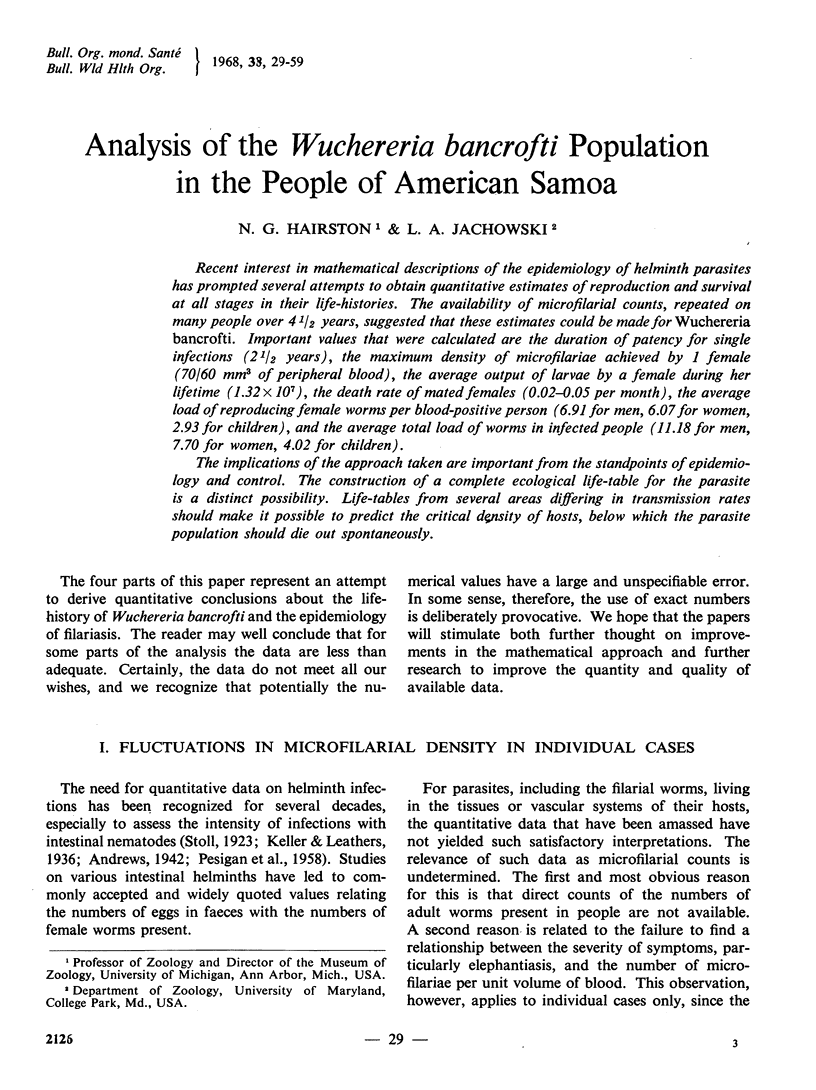
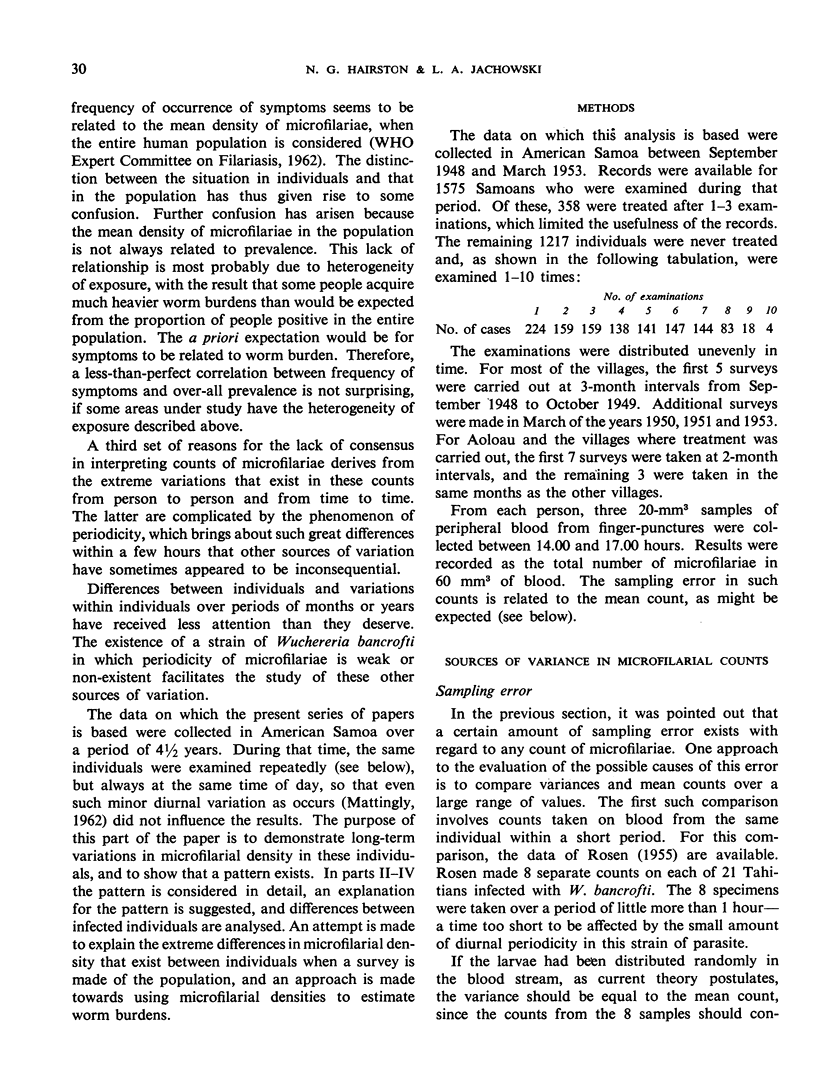
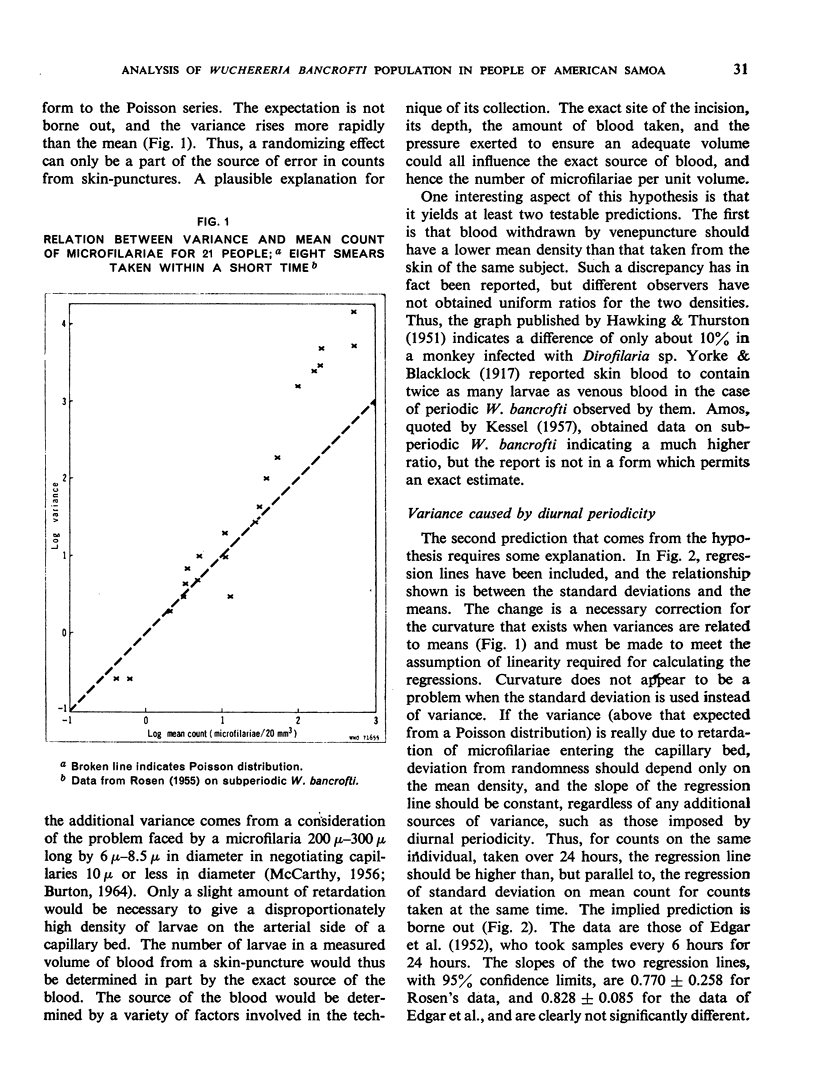
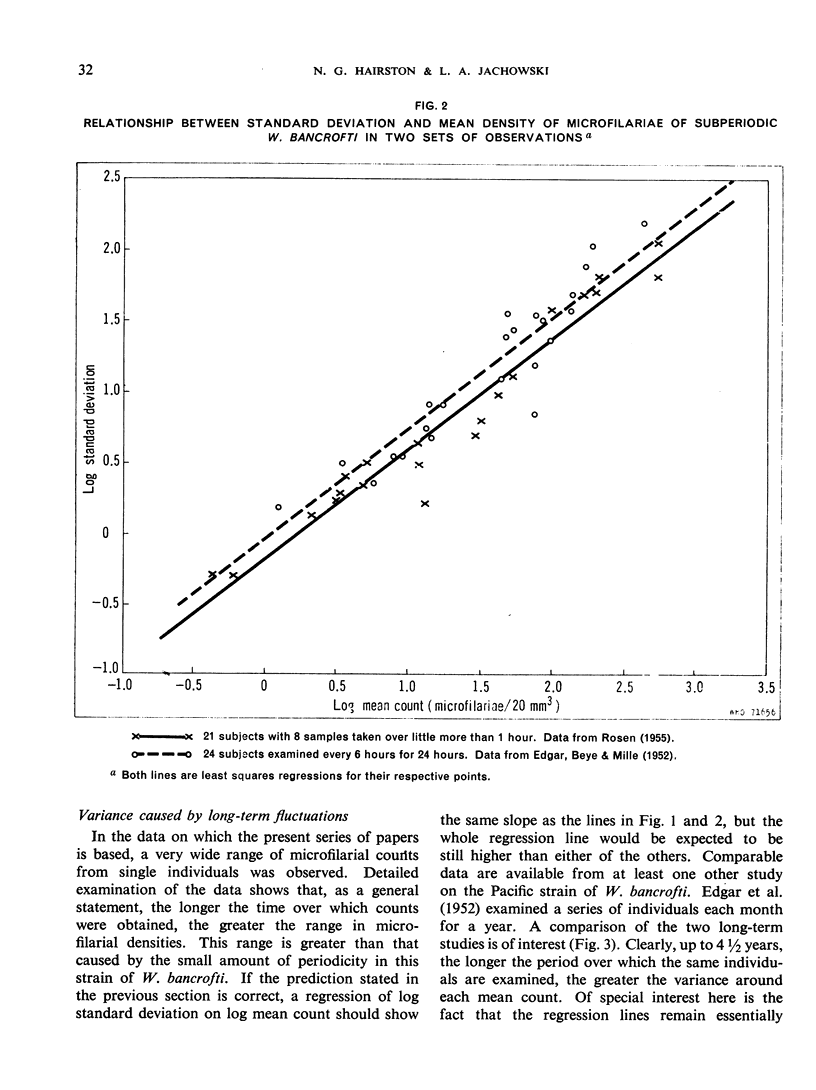
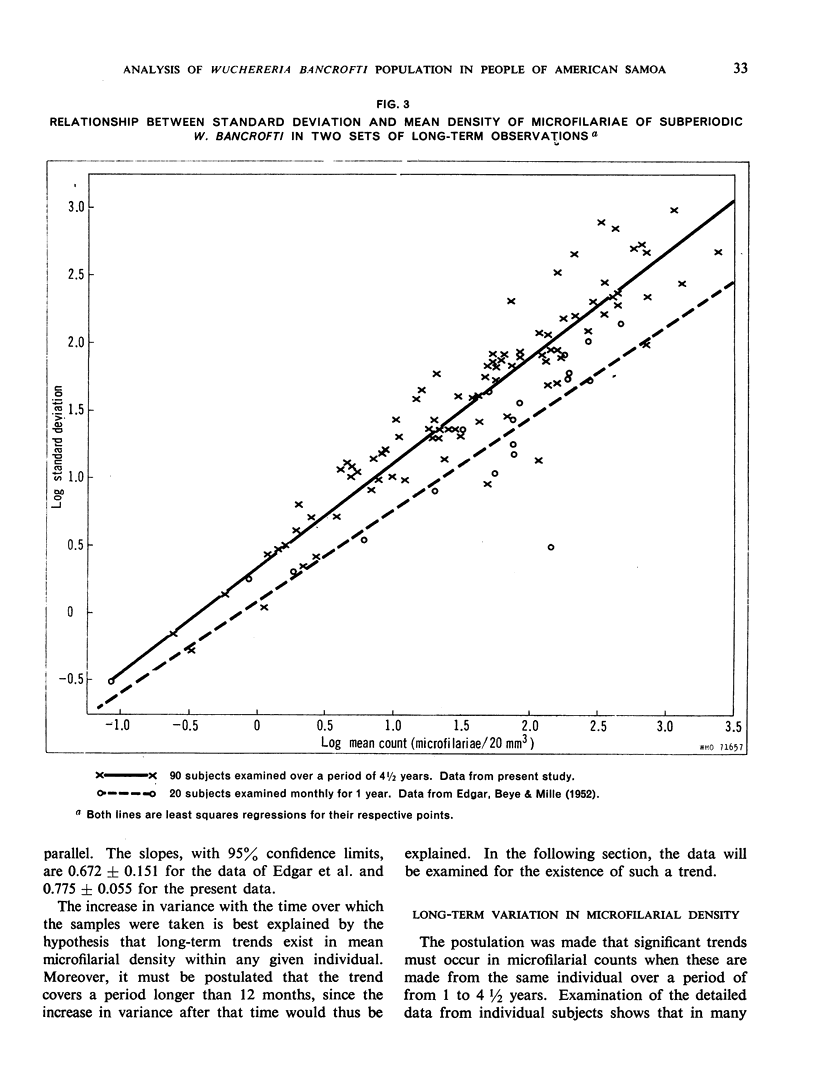
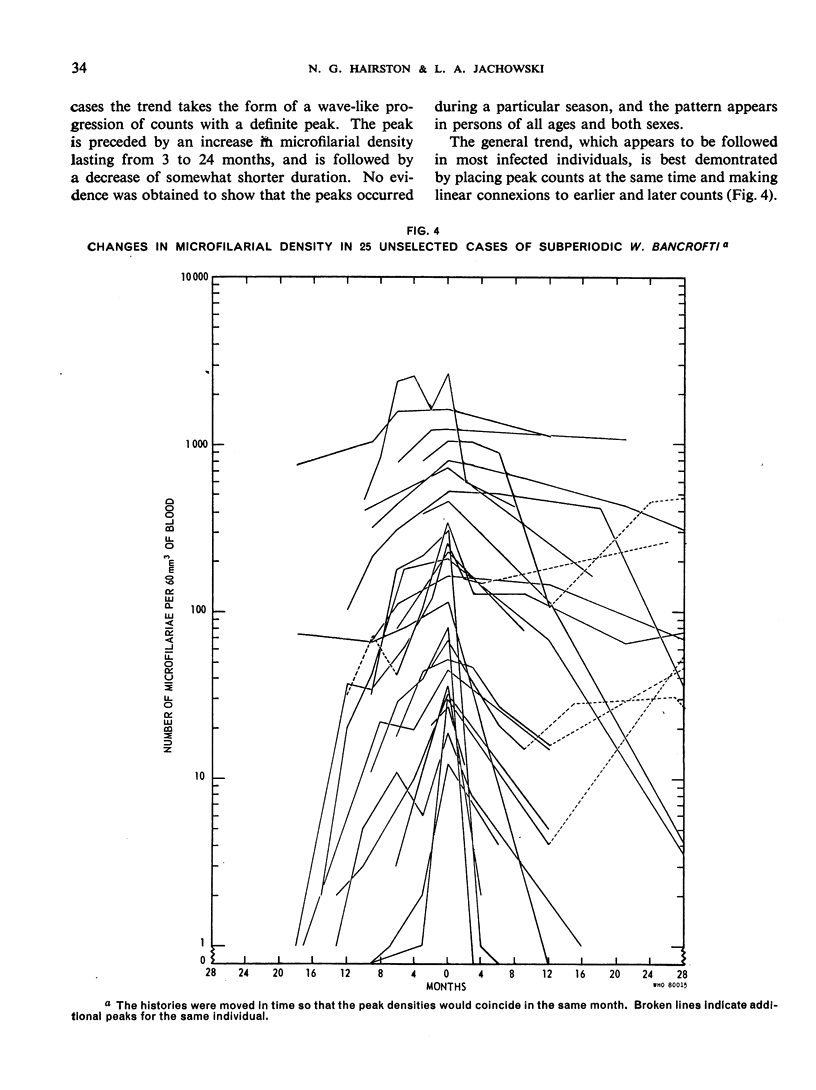
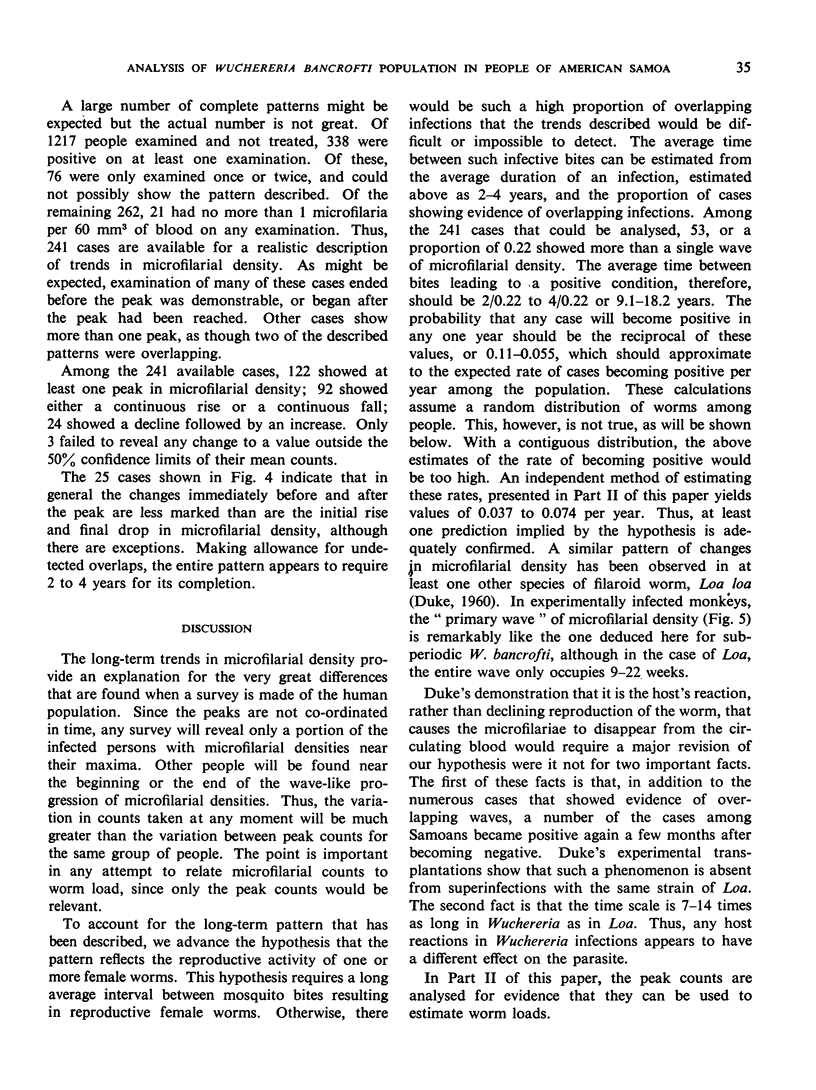
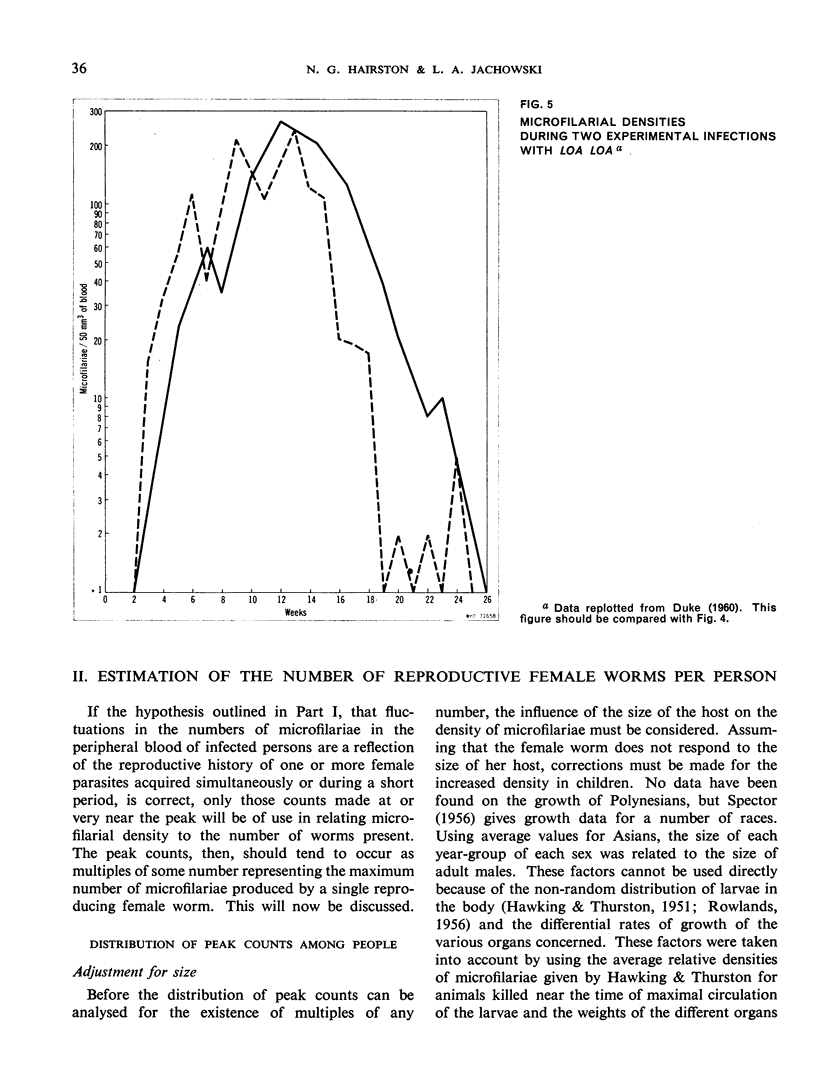
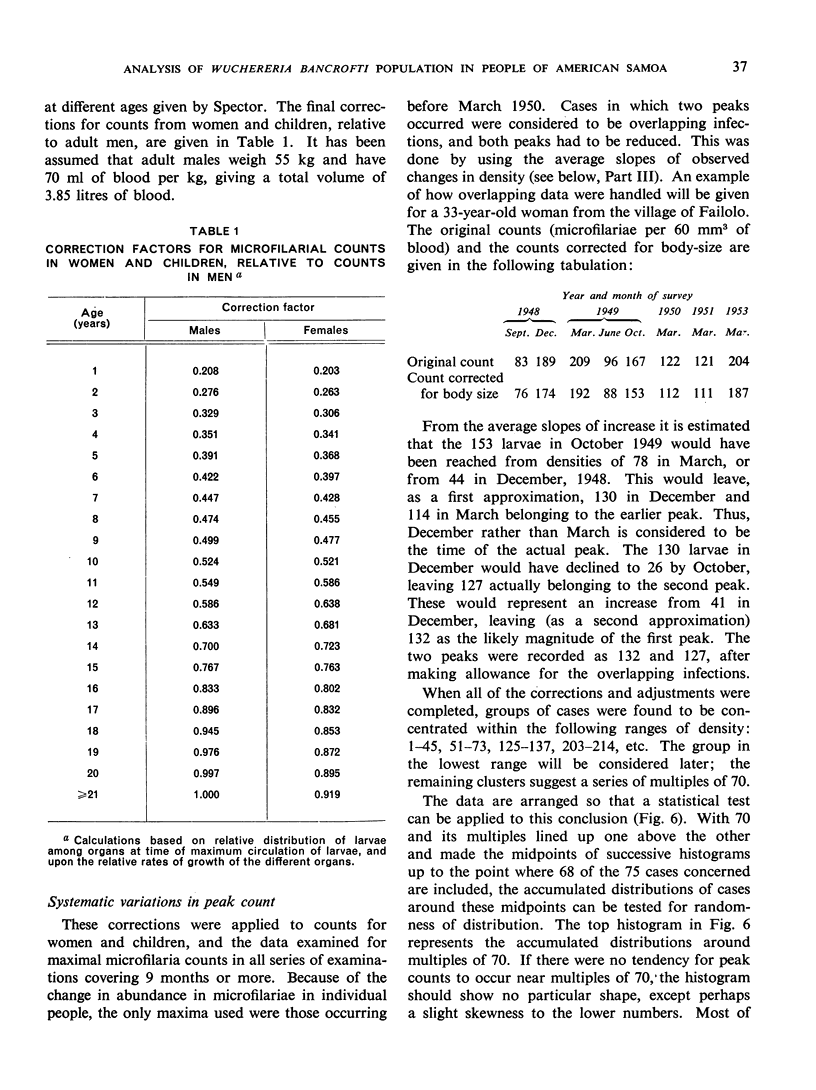
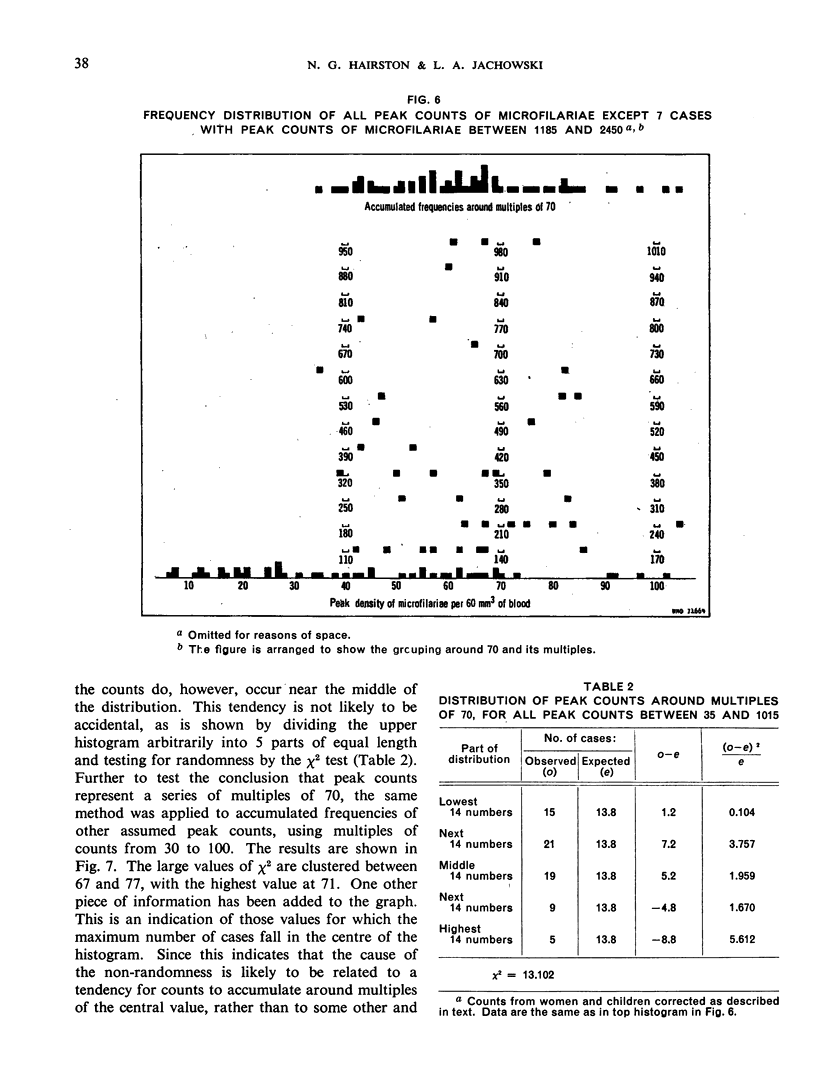
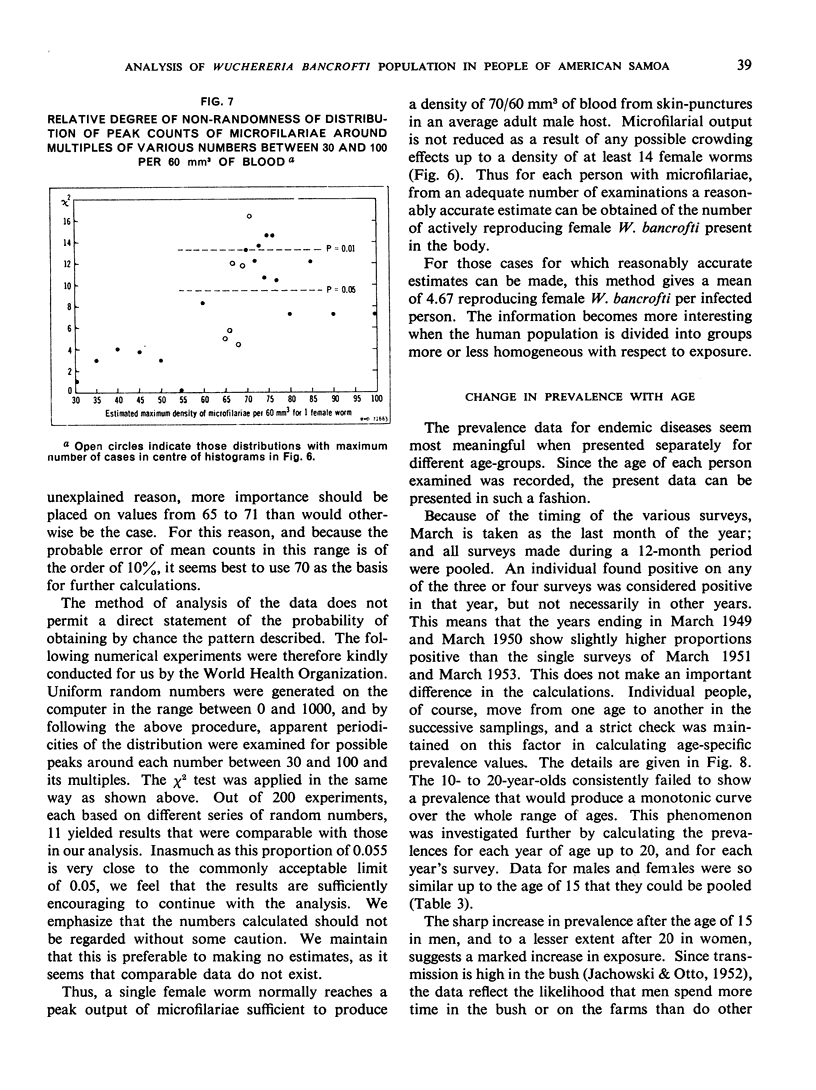

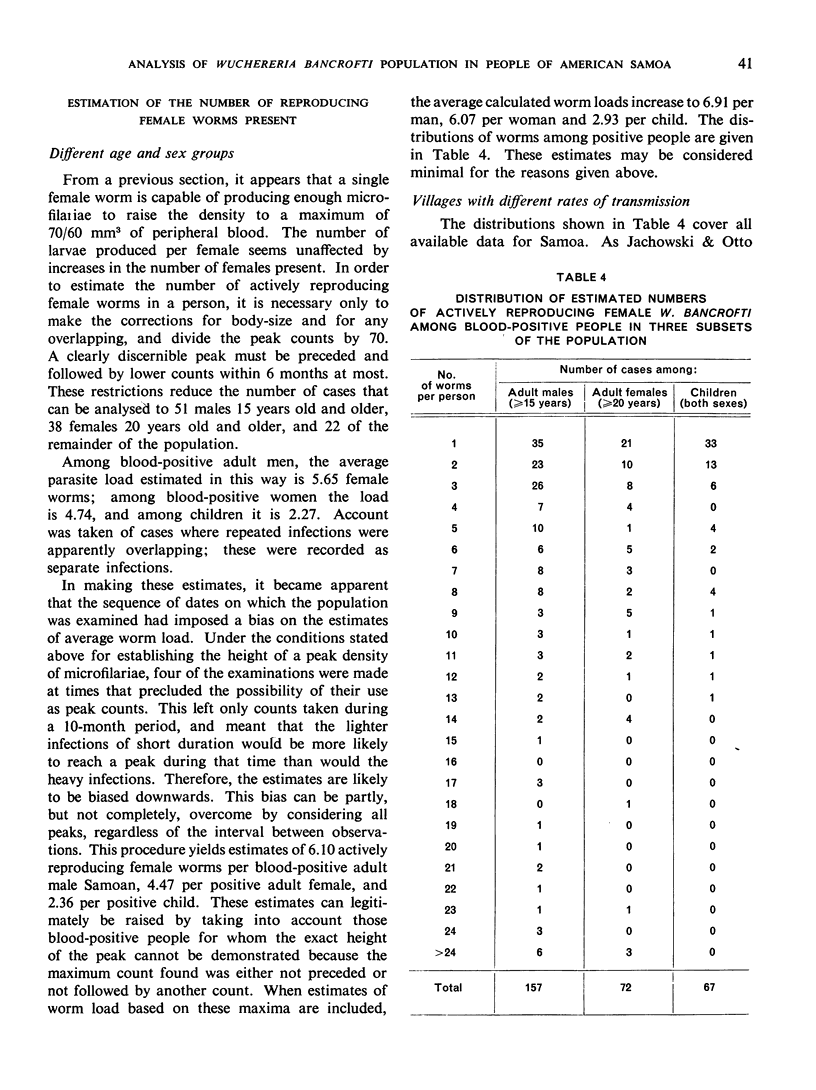
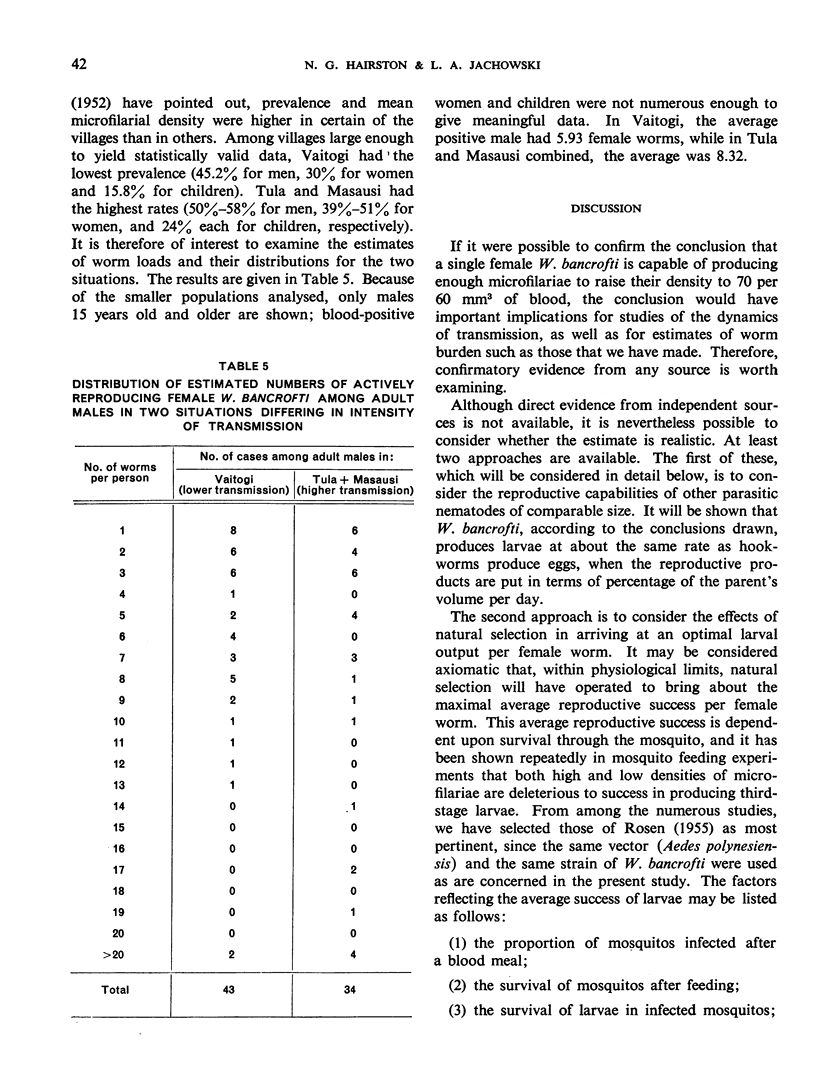
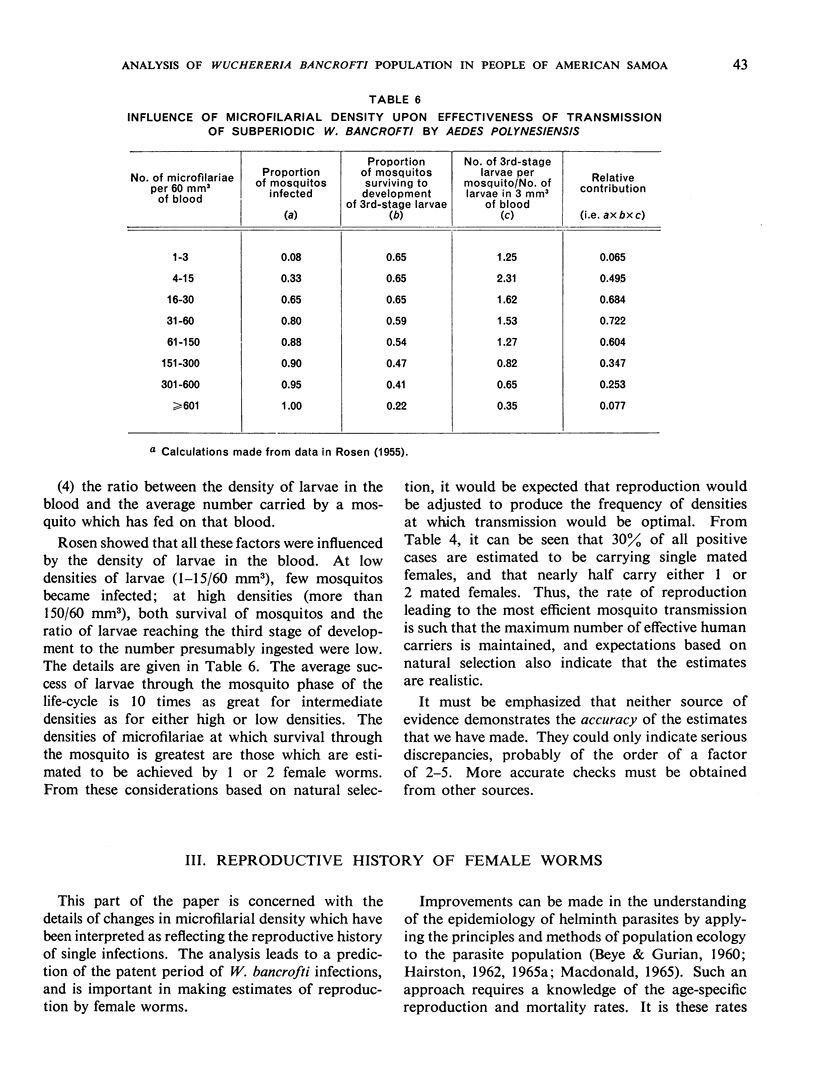
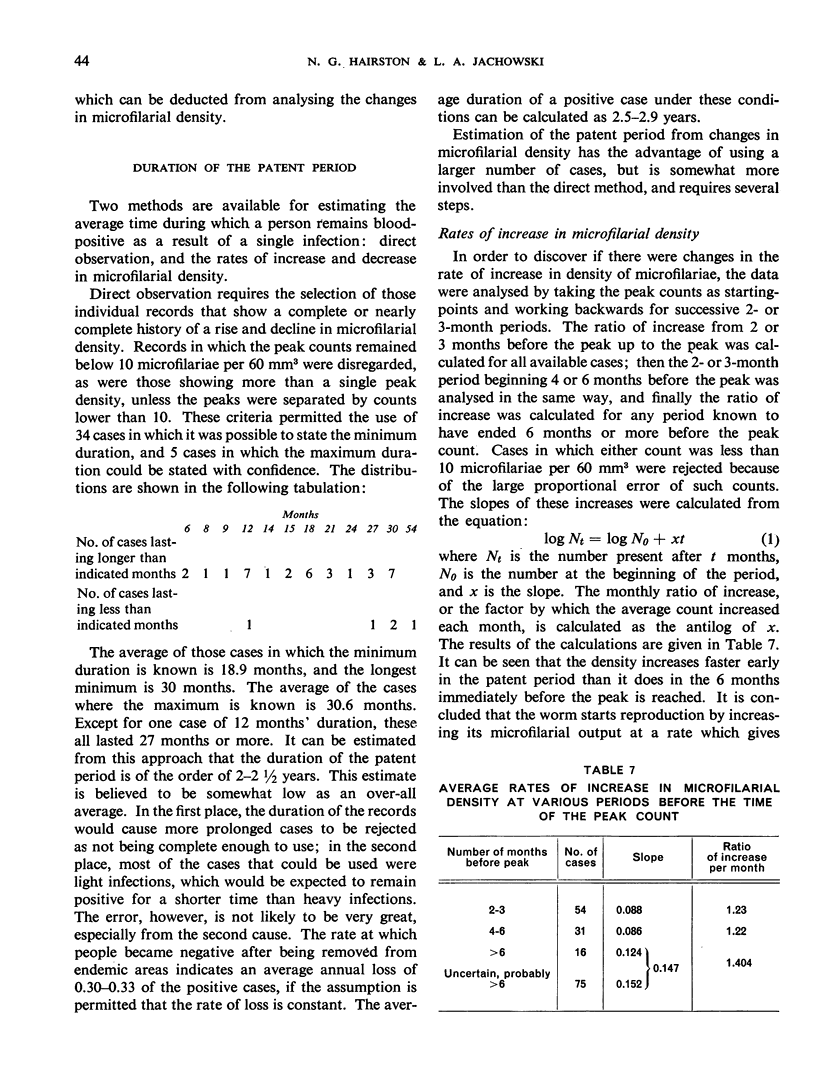
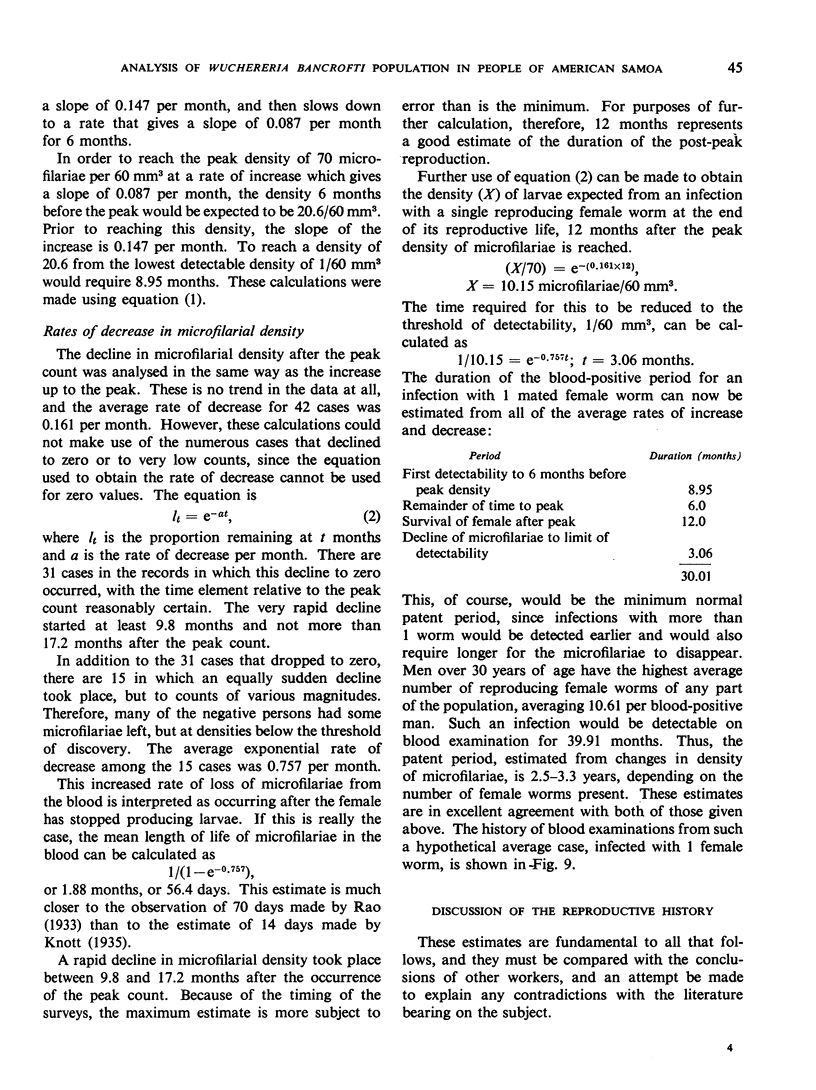
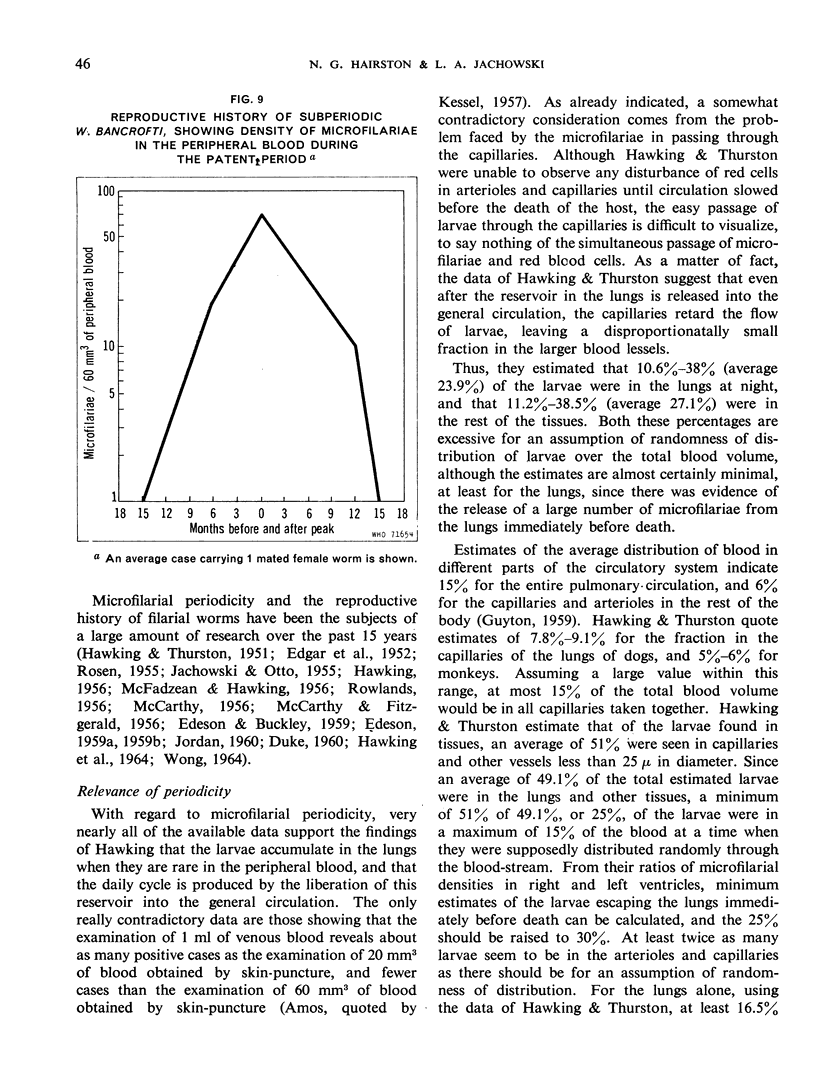
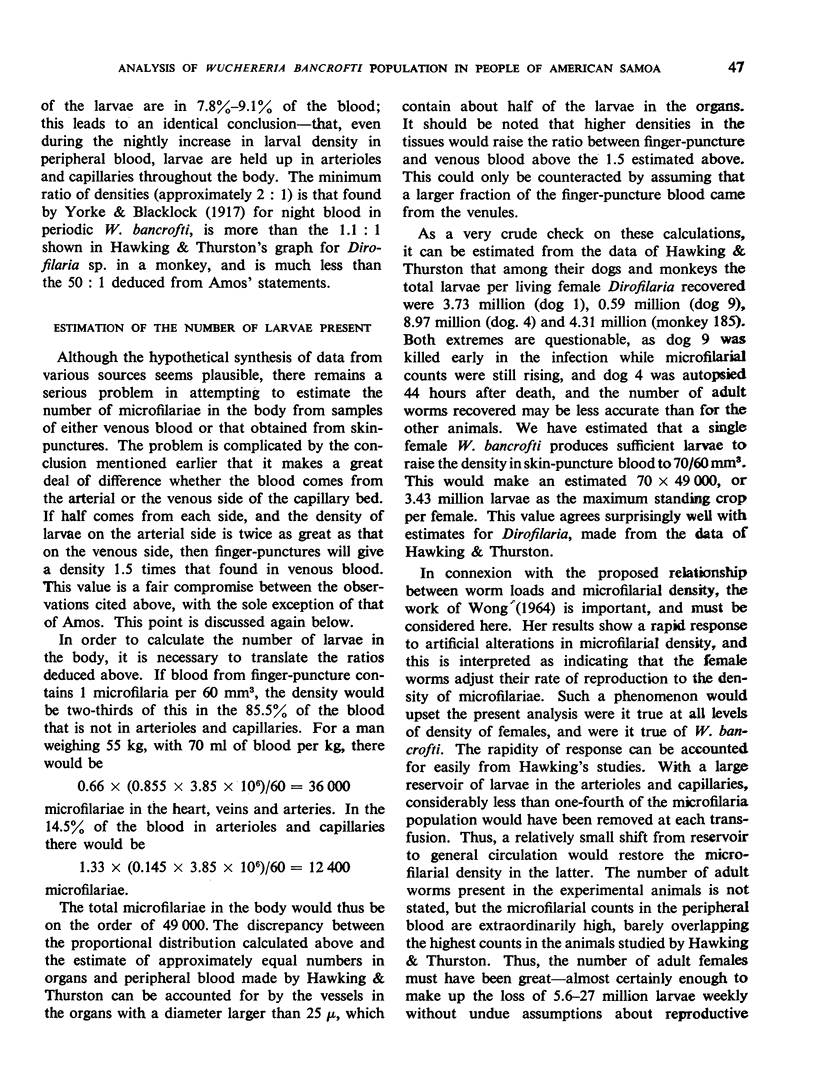
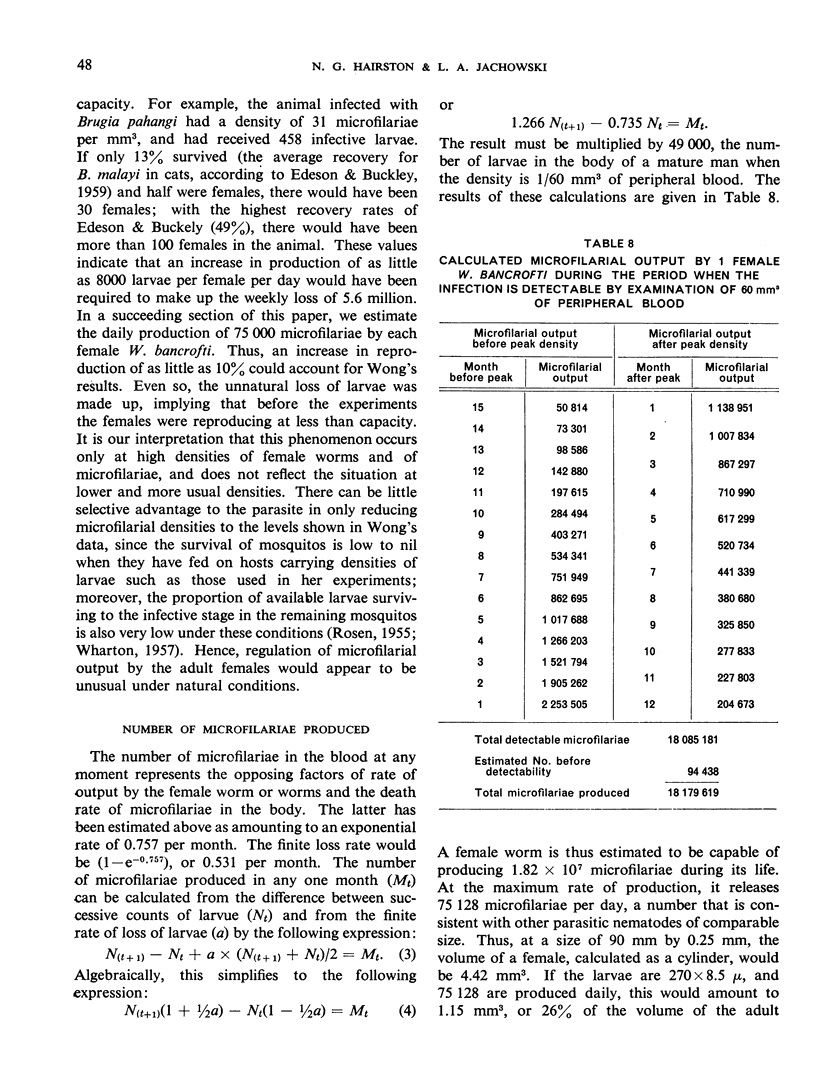
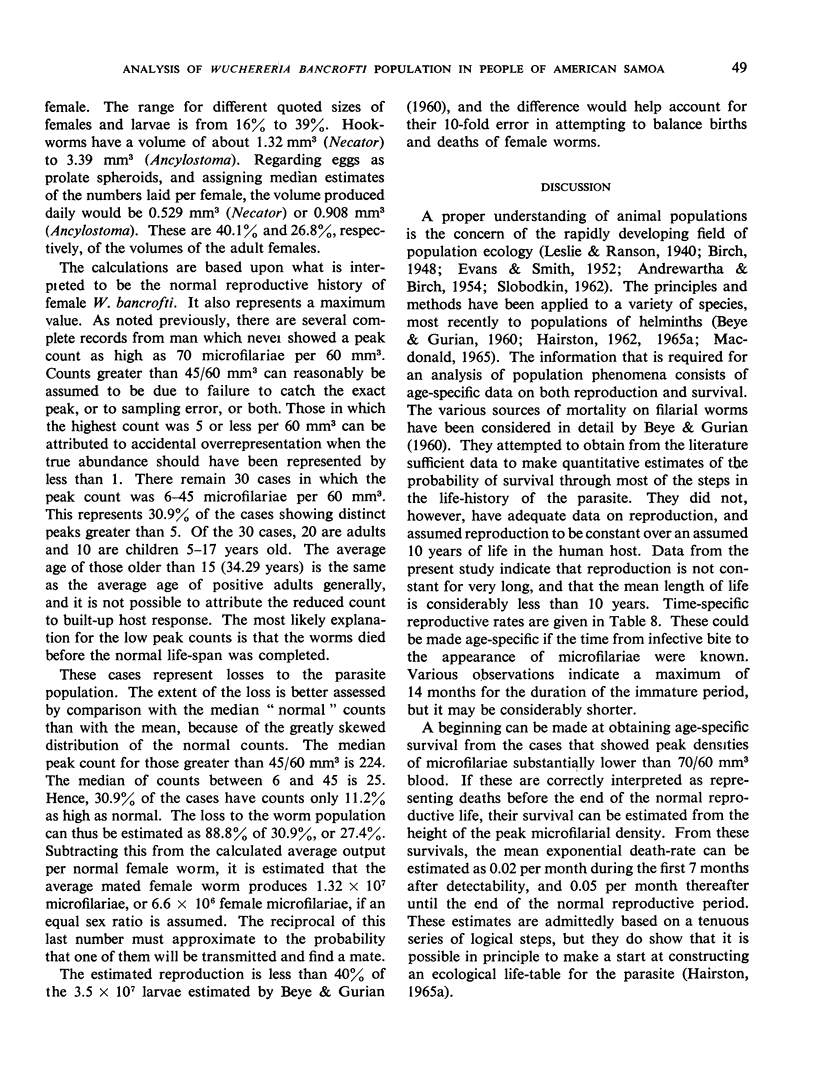
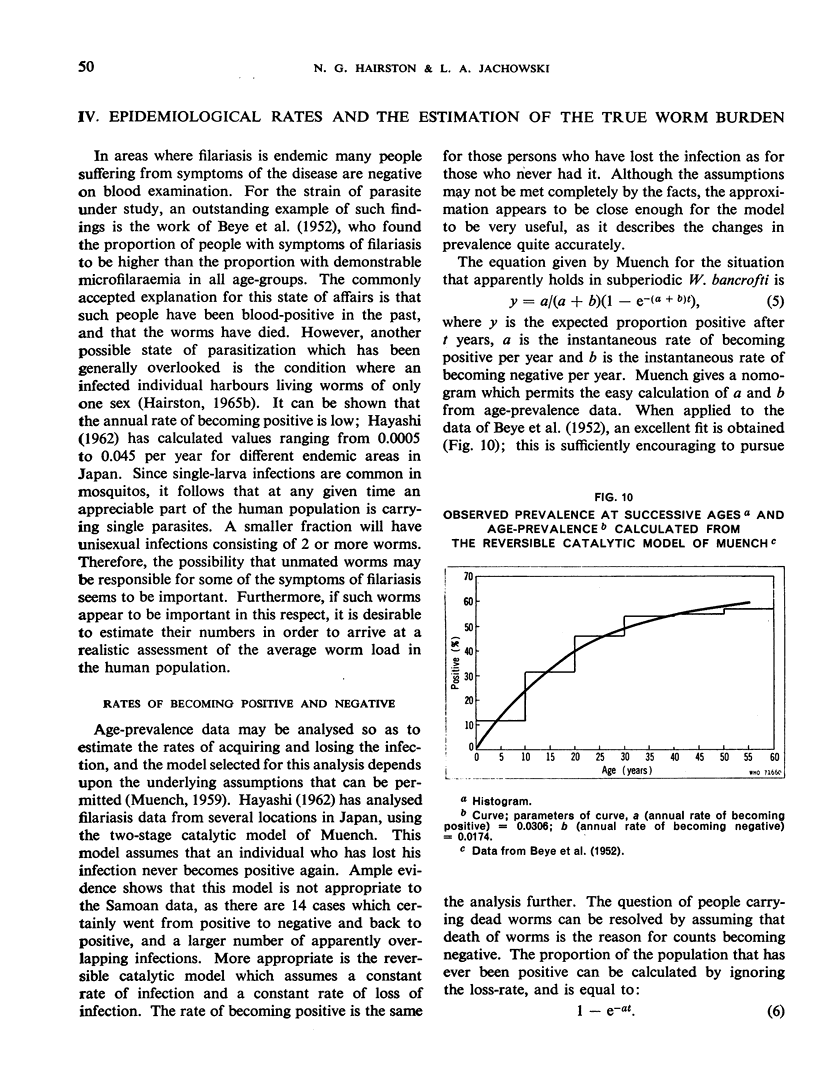
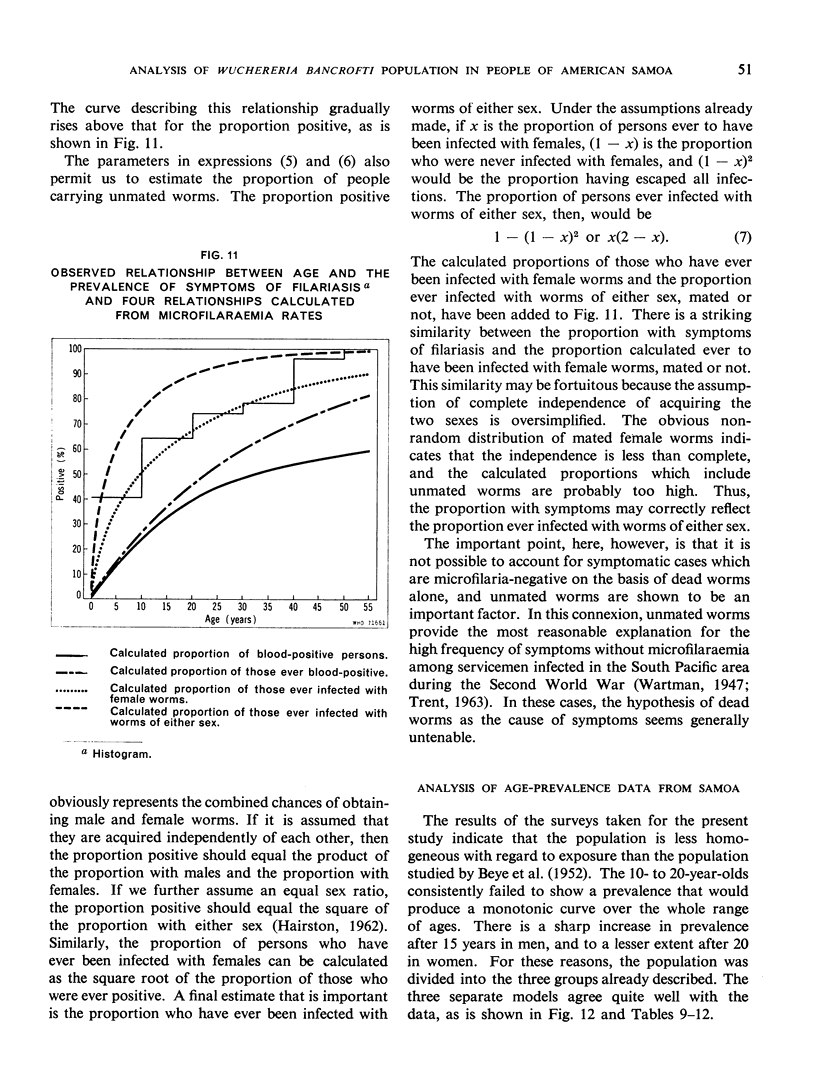
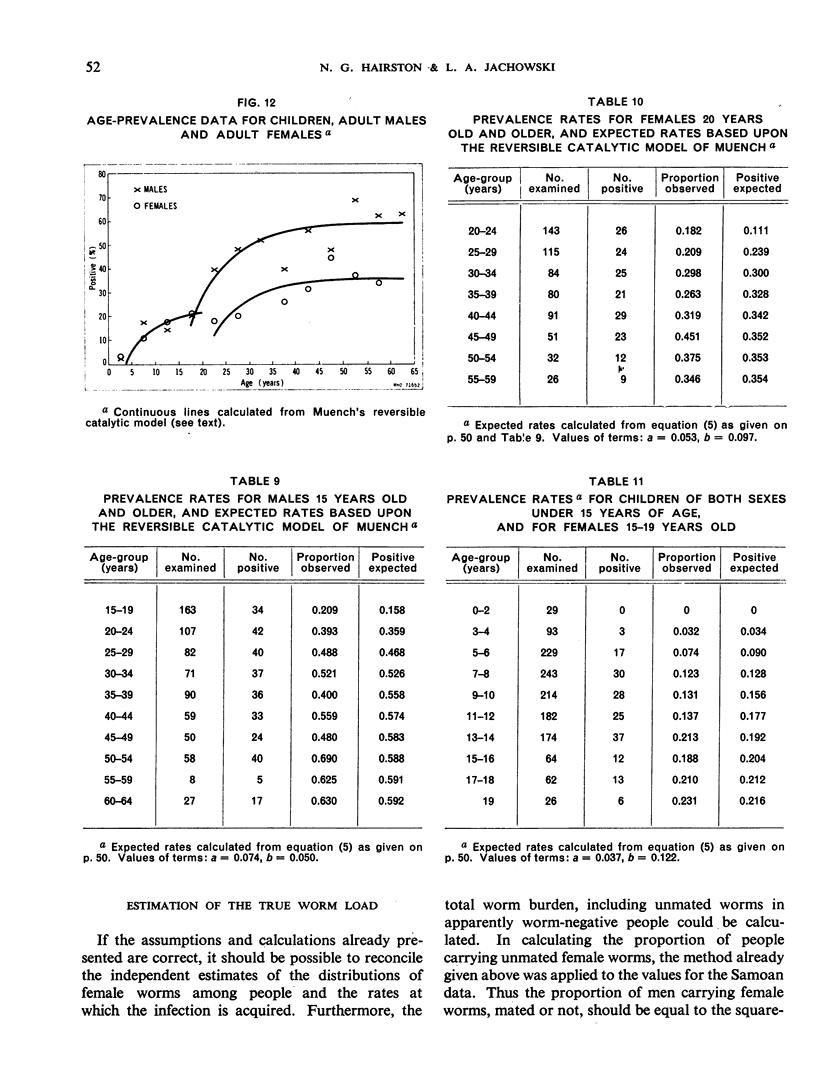
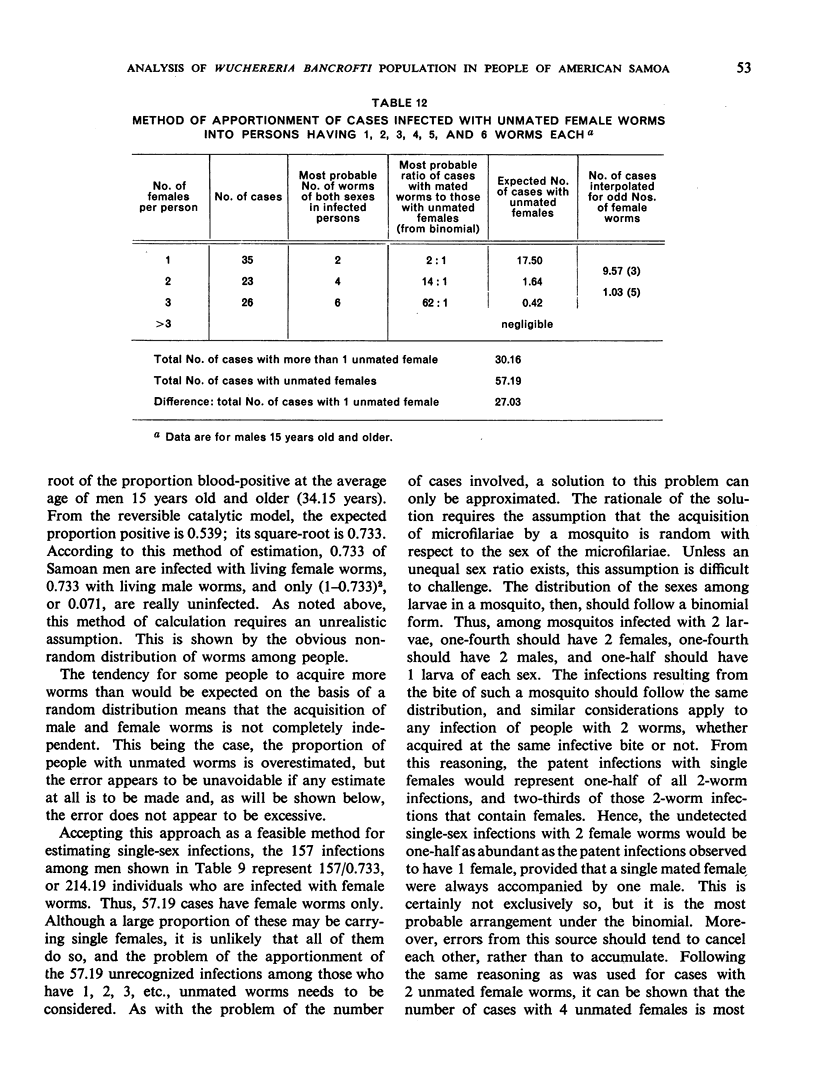
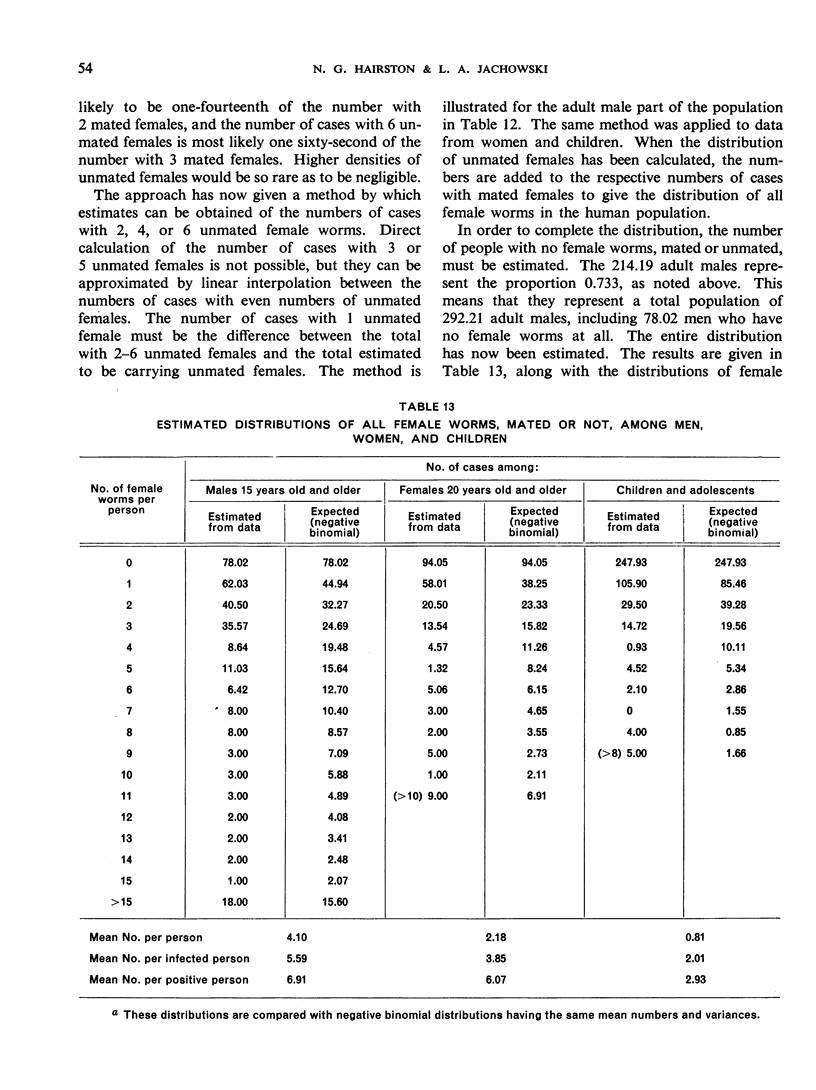
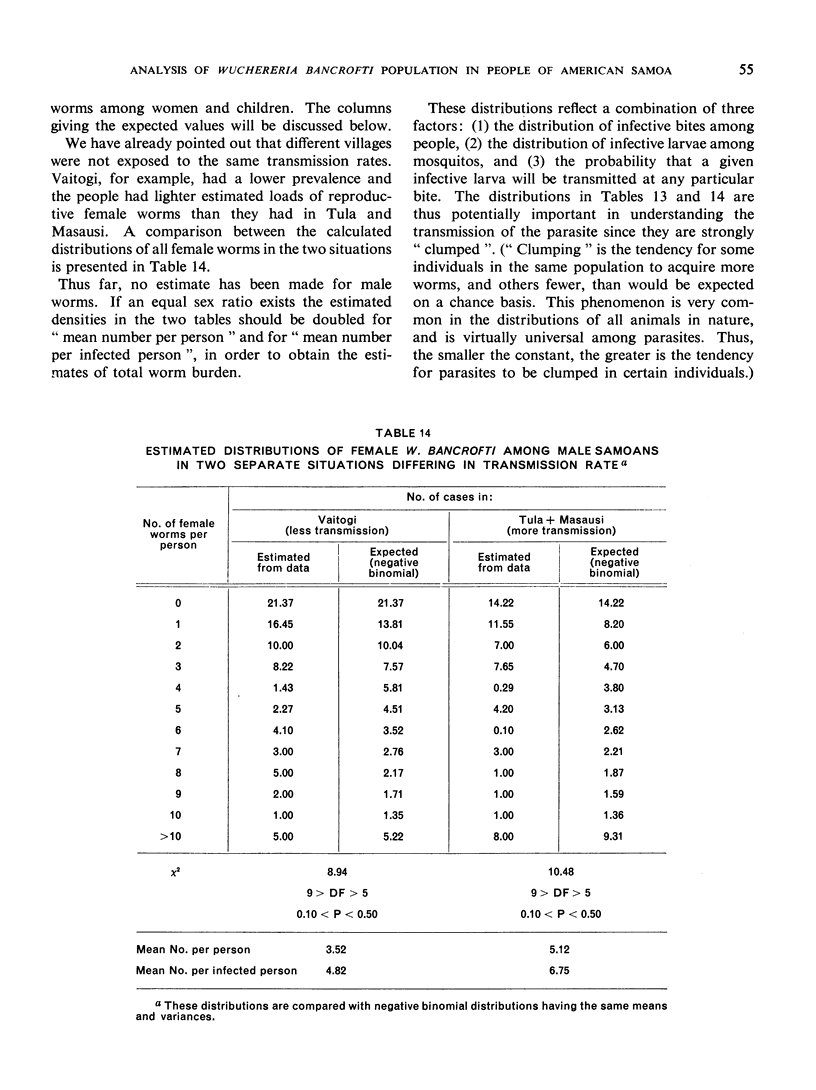
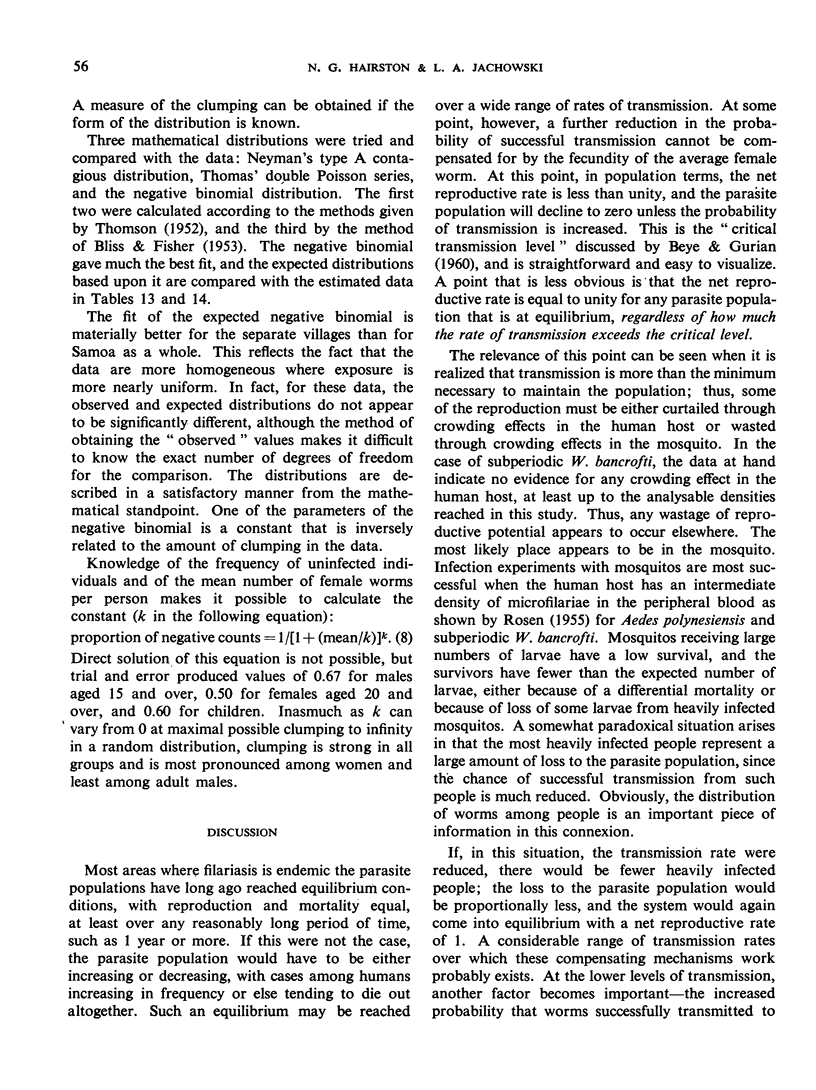
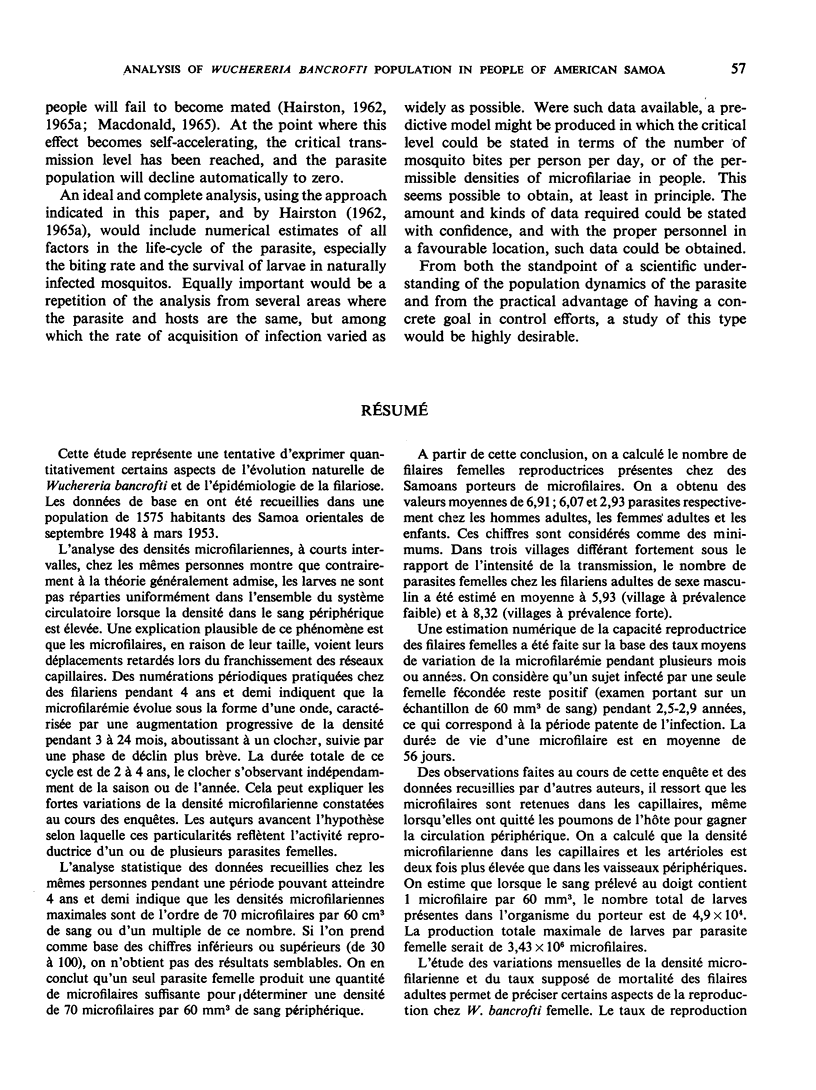
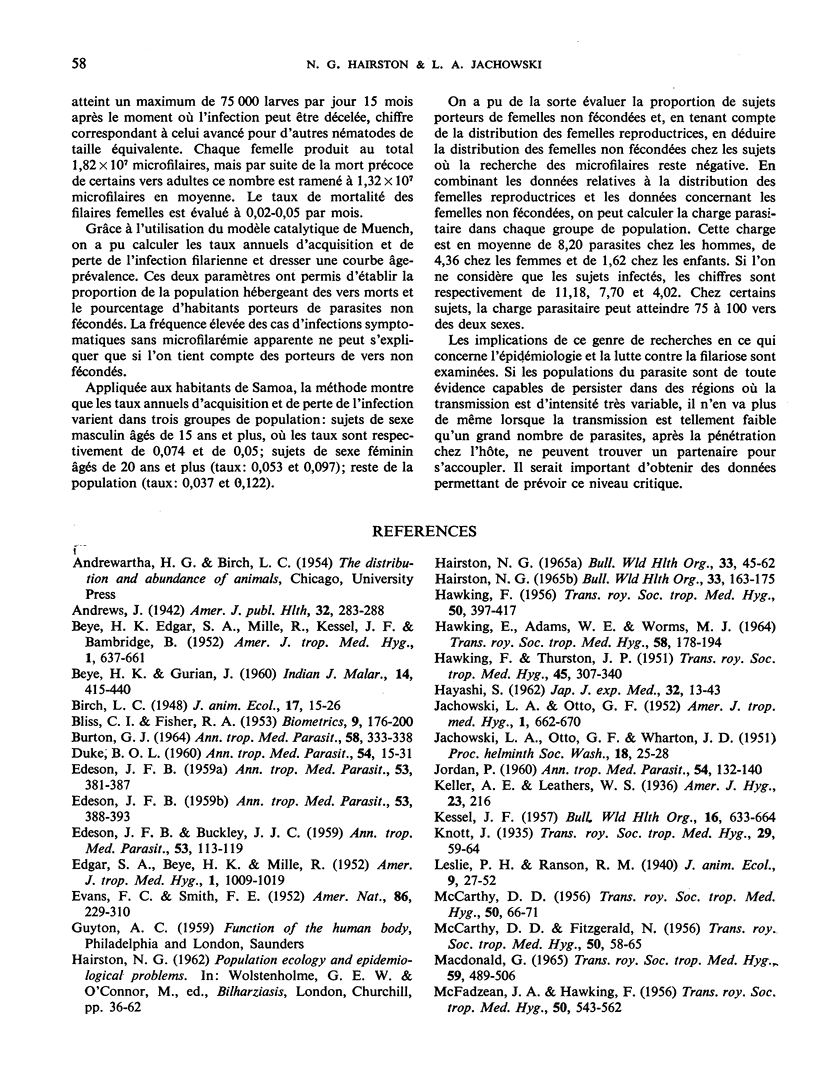
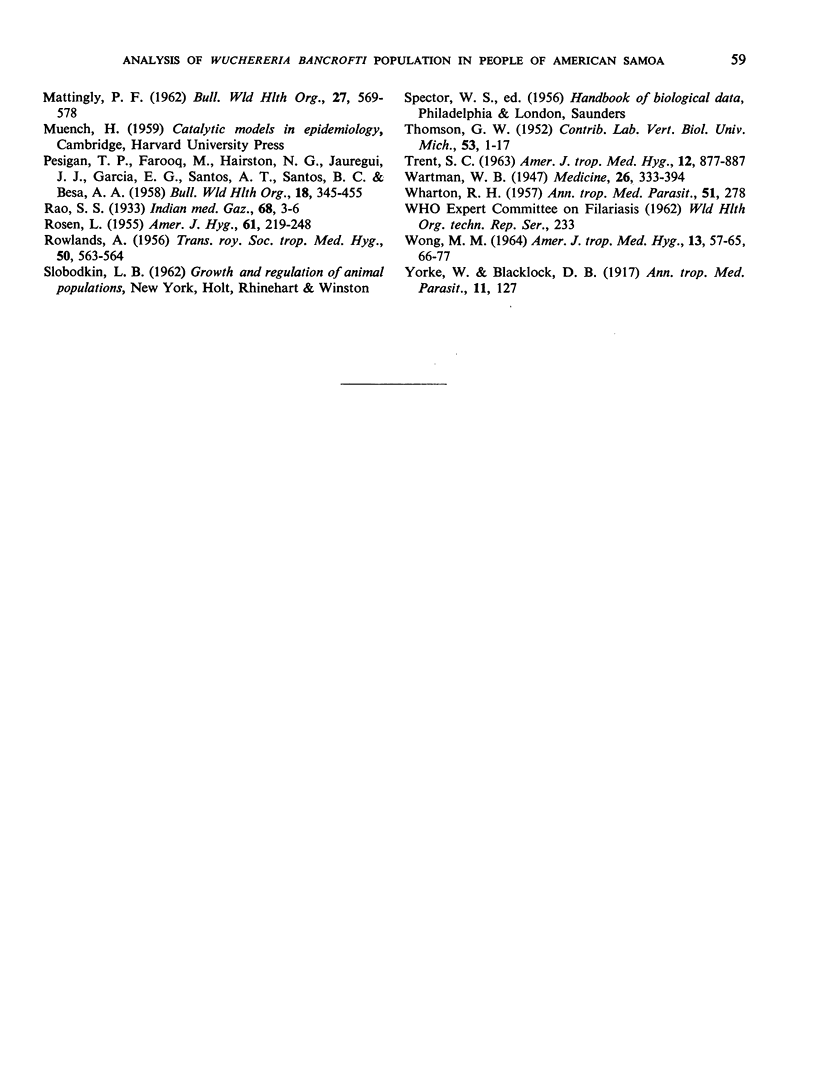
Selected References
These references are in PubMed. This may not be the complete list of references from this article.
- Andrews J. New Methods of Hookworm Disease Investigation and Control. Am J Public Health Nations Health. 1942 Mar;32(3):282–288. doi: 10.2105/ajph.32.3.282. [DOI] [PMC free article] [PubMed] [Google Scholar]
- BEYE H. K., EDGAR S. A., MILLE R., KESSEL J. F., BAMBRIDGE B. Preliminary observations on the prevalence, clinical manifestations and control of filariasis in the Society Islands. Am J Trop Med Hyg. 1952 Jul;1(4):637–661. doi: 10.4269/ajtmh.1952.1.637. [DOI] [PubMed] [Google Scholar]
- BURTON G. J. THE INTAKE OF MICROFILARIAE OF WUCHERERIA BANCROFTI BY CULEX PIPIENS FATIGANS IN BRITISH GUIANA. Ann Trop Med Parasitol. 1964 Sep;58:333–338. doi: 10.1080/00034983.1964.11686251. [DOI] [PubMed] [Google Scholar]
- DUKE B. O. Studies on loiasis in monkeys. II.--The population dynamics of the microfilariae of Loa in experimentally infected drills (Mandrillus leucophaeus). Ann Trop Med Parasitol. 1960 Apr;54:15–31. [PubMed] [Google Scholar]
- EDESON J. F., BUCKLEY J. J. Studies on filariasis in Malaya: on the migration and rate of growth of Wuchereria malayi in experimentally infected cats. Ann Trop Med Parasitol. 1959 Apr;53(1):113–119. doi: 10.1080/00034983.1959.11685907. [DOI] [PubMed] [Google Scholar]
- EDESON J. F. Studies on filariasis in Malaya: the accuracy of blood survevs. Ann Trop Med Parasitol. 1959 Dec;53:388–393. doi: 10.1080/00034983.1959.11685937. [DOI] [PubMed] [Google Scholar]
- EDESON J. F. Studies on filariasis in Malaya: the periodicity of the microfilariae of Brugia malayi and B. pahangi in animals. Ann Trop Med Parasitol. 1959 Dec;53:381–387. doi: 10.1080/00034983.1959.11685936. [DOI] [PubMed] [Google Scholar]
- EDGAR S. A., BEYE H. K., MILLE R. A preliminary report on a periodic tendency of microfilariae of Wuchereria bancrofti observed in Tahita, French Oceania. Am J Trop Med Hyg. 1952 Nov;1(6):1009–1019. doi: 10.4269/ajtmh.1952.1.1009. [DOI] [PubMed] [Google Scholar]
- HAWKING F., ADAMS W. E., WORMS M. J. THE PERIODICITY OF MICROFILARIAE. VII. THE EFFECT OF PARASYMPATHETIC STIMULANTS UPON THE DISTRIBUTION OF MICROFILARIAE. Trans R Soc Trop Med Hyg. 1964 Mar;58:178–194. doi: 10.1016/0035-9203(64)90008-2. [DOI] [PubMed] [Google Scholar]
- HAWKING F., MCFADZEAN J. A. The periodicity of microfilariae. V. Stimuli affecting the periodic migration of the microfilariae of Wuchereria bancrofti and of Loa loa in man. Trans R Soc Trop Med Hyg. 1956 Nov;50(6):543–562. doi: 10.1016/0035-9203(56)90058-x. [DOI] [PubMed] [Google Scholar]
- HAWKING F., THURSTON J. P. The periodicity of microfilariae. II. The explanation of its production. Trans R Soc Trop Med Hyg. 1951 Dec;45(3):329–340. doi: 10.1016/s0035-9203(51)80004-x. [DOI] [PubMed] [Google Scholar]
- HAWKING F. The periodicity of microfilariae. IV. Stimuli affecting the migration of the microfilariae of Dirofilaria aethiops, D. immitis, D. repens, Dipetalonema blanci and Litomosoides carinii. Trans R Soc Trop Med Hyg. 1956 Jul;50(4):397–417. doi: 10.1016/0035-9203(56)90048-7. [DOI] [PubMed] [Google Scholar]
- HAYASHI S. A mathematical analysis on the epidemiology of Bancroftian and Malayan filariasis in Japan. Jpn J Exp Med. 1962 Feb;32:13–43. [PubMed] [Google Scholar]
- Hairston N. G. An analysis of age-prevalence data by catalytic models. A contribution to the study of bilharziasis. Bull World Health Organ. 1965;33(2):163–175. [PMC free article] [PubMed] [Google Scholar]
- Hairston N. G. On the mathematical analysis of schistosome populations. Bull World Health Organ. 1965;33(1):45–62. [PMC free article] [PubMed] [Google Scholar]
- JACHOWSKI L. A., Jr, OTTO G. F. Filariasis in American Samoa. II. Evidence of transmission outside of villages. Am J Trop Med Hyg. 1952 Jul;1(4):662–670. doi: 10.4269/ajtmh.1952.1.662. [DOI] [PubMed] [Google Scholar]
- JORDAN P. Bancroftian filariasis in Tanganyika: observations on elephantiasis, microfilarial density, genital filariasis and microfilaraemia rates. Ann Trop Med Parasitol. 1960 Jun;54:132–140. doi: 10.1080/00034983.1960.11685968. [DOI] [PubMed] [Google Scholar]
- KESSEL J. F. An effective programme for the control of filariasis in Tahiti. Bull World Health Organ. 1957;16(3):633–664. [PMC free article] [PubMed] [Google Scholar]
- MCCARTHY D. D., FITZGERALD N. I. Habit, habitat and hyperfilariation in the epidemiology of filariasis in Western Samoa. Trans R Soc Trop Med Hyg. 1956 Jan;50(1):58–65. doi: 10.1016/0035-9203(56)90009-8. [DOI] [PubMed] [Google Scholar]
- MCCARTHY D. D. II. Pseudo-periodicity in the Pacific variety of Wuchereria bancrofti: a study of fluctuations in the density of microfilariae in the peripheral blood of Samoans. Trans R Soc Trop Med Hyg. 1956 Jan;50(1):66–71. doi: 10.1016/0035-9203(56)90010-4. [DOI] [PubMed] [Google Scholar]
- Macdonald G. The dynamics of helminth infections, with special reference to schistosomes. Trans R Soc Trop Med Hyg. 1965 Sep;59(5):489–506. doi: 10.1016/0035-9203(65)90152-5. [DOI] [PubMed] [Google Scholar]
- PESIGAN T. P., FAROOQ M., HAIRSTON N. G., JAUREGUI J. J., GARCIA E. G., SANTOS A. T., SANTOS B. C., BESA A. A. Studies on Schistosoma japonicum infection in the Philippines. 1. General considerations and epidemiology. Bull World Health Organ. 1958;18(3):345–455. [PMC free article] [PubMed] [Google Scholar]
- ROWLANDS A. The distribution of microfilariae of Wuchereria bancrofti in human organs. Trans R Soc Trop Med Hyg. 1956 Nov;50(6):563–564. doi: 10.1016/0035-9203(56)90059-1. [DOI] [PubMed] [Google Scholar]
- TRENT S. C. REEVALUATION OF WORLD WAR II VETERANS WITH FILARIASIS ACQUIRED IN THE SOUTH PACIFIC. Am J Trop Med Hyg. 1963 Nov;12:877–887. doi: 10.4269/ajtmh.1963.12.877. [DOI] [PubMed] [Google Scholar]
- WHARTON R. H. Studies on filariasis in Malaya: observations on the development of Wuchereria malayi in Mansonia (Mansonioides) longipalpis. Ann Trop Med Parasitol. 1957 Sep;51(3):278–296. doi: 10.1080/00034983.1957.11685817. [DOI] [PubMed] [Google Scholar]
- WONG M. M. STUDIES ON MICROFILAREMIA IN DOGS. I. A SEARCH FOR THE MECHANISMS THAT STABILIZE THE LEVEL OF MICROFILAREMIA. Am J Trop Med Hyg. 1964 Jan;13:57–65. [PubMed] [Google Scholar]


